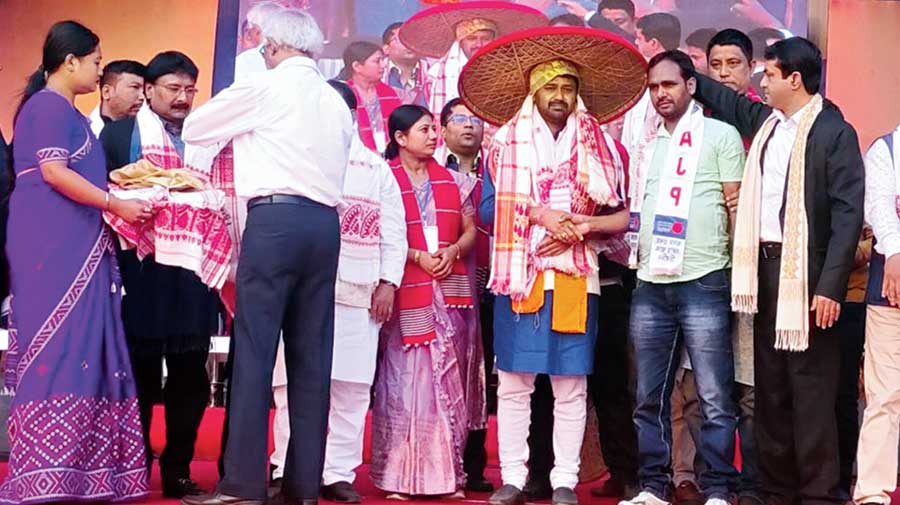The Assam Jatiya Parishad (AJP), the newly floated regional party backed by the All Assam Students Union and Asom Jatiyatabadi Yuba Chatra Parishad, on Thursday not only appointed its first president but also spelt out its political roadmap, including an assurance to protect the rights of those accepted as Indian citizens in accordance with the 1985 Assam Accord.
Former AASU general secretary Lurinjyoti Gogoi was appointed the first president of the AJP at its well-attended first political convention held at Sivasagar Boarding Field in Upper Assam.
In his presidential address, the 40-year-old Lurinjyoti, a masters in mathematics and education from Dibrugarh University, made it clear that those who have come to Assam between 1951 and 1971 have nothing to fear since they have been accepted as Indians under the Assam Accord. The Accord had fixed March 24, 1971, as the date for detection and deportation of illegal foreigners staying in Assam. The Accord was the culmination of the six-year-long Assam Movement against illegal foreigners.
Lurinjyoti’s announcement is significant because there is a demand from certain groups to make 1951 as the cut-off date for protection of the Assamese people after the final National Register of Citizens (NRC) was published on August 31, 2019. Over 19 lakh applicants were left out of the register. The final NRC, updated on the basis of the 1951 NRC and the voter list before March 24, 1971, is yet to be notified.
The AJP was formed in September because it was the “desire” of the people to have a strong regional party in the wake the Centre’s decision to go ahead with the “anti-Assam’ and “unconstitutional” Citizenship Amendment Act. The AASU and AJYCP leadership were present at the convention.
Those opposing the CAA see the Asom Gana Parishad (AGP), the state’s leading regional party formed after the Accord with the backing of the AASU and the Asom Gana Sangram Parishad, as “doing the bidding” of the BJP instead of “upholding” the interests of Assam, especially on the CAA.
The role of the AGP, an ally of the BJP, spurred the formation of the AJP. The new party on Thursday projected itself as the only regional alternative in the 2021 Assembly polls by indirectly attacking the AGP as a betrayer.
The CAA makes it easy to secure Indian citizenship for non-Muslims who had entered the country till 2014 from Bangladesh, Pakistan and Afghanistan. Most in Assam see the CAA as a threat to their culture and identity because the state has already taken the burden of those who came before March 24, 1971.
Lurinjyoti said that those who came before March 24, 1971, should not live in fear and confusion. “Some people try to create confusion and fear among this section but they have nothing to fear. Since they have been accepted as Indian citizens, they will enjoy their rights. We are for peaceful existence of all communities. The AJP is for a strong, secular and inclusive regionalism that will work for the all-round development of Assam and protection of its culture and identity. We will surely form the next government, a government of Assam’s dreams,” he said.
Adip Phukan, who was appointed as AJP vice-president, and spokesperson Ziaur Rahman told The Telegraph that since these people have been accepted as Indian citizens as per the 1985 Accord, it will be the bounden duty of the party to ensure their rights.
The announcement, political watchers said, may take the AJP closer to the Bengali-speaking as well as the Hindi-speaking populations, especially those who feel threatened by the “shifting” citizenship cut-off date.
They said it may impact the Congress and the AIUDF “eyeing” the Muslim votes and the ruling BJP “banking” on the Bengali Hindu and Hindi speakers’ votes in 2021.
Lurinjyoti, one of the leading faces of the anti-CAA movement in Assam last year, appealed to the people to be part of the AJP’s journey to secure their political, economic, linguistic and cultural rights.
“We are in for the long haul. 2021 is not our goal. For us, it will be Assam first and forever,” he said, referring to the AJP’s slogan.
The two-day political convention of the AJP was not short of political messaging. Apart from allaying fears on the citizenship issue, the event was held at Sivasagar, the capital of the Ahom dynasty. Its founder Chaolung Sukapha is referred to as the architect of “Bor Asom” (greater Assam). Lurinjyoti invoked Sukapha in his speech and also sought the release of all anti-CAA activists, including Krishak Mukti Sangram Samiti leader Akhil Gogoi.
The KMSS has also floated a regional party, Raijor Dal. The AJP and Lurinjyoti’s support for Akhil, arrested over a year ago during the anti-CAA protests, is also seen as a move to get all anti-BJP voters behind the regional forces.
Lurinjyoti, as well as former chief ministers Tarun Gogoi and Hiteswar Saikia, all belong to the influential Ahom community which plays a decisive role in Assam politics.
Other announcements made by the AJP leadership:
- The party will contest all 126 Assembly seats.
- It has sought voting through ballots instead of EVMs
- It will have no truck with either the Congress or the BJP.
- It will continue to oppose the CAA, ensure an error-free NRC and implementation of Clause 6 of the Assam Accord.
- It sought the release of all anti-CAA activists, including Akhil Gogoi.
- It called for a scientific solution to the big dam issues that will ensure proper protection to people living in downstream areas.
- It will focus on improving the education sector to boost employability and harnessing the state’s natural resources.

